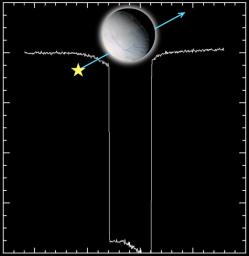UVIS Directly Measures Enceladus' atmosphere

After not sensing the atmosphere during an occultation in February, UVIS finally observed the atmosphere first observed by the magnetometer instrument. The UVIS detection came during another stellar occultation, this time of gamma Orionis, or Bellatrix. This star turned out to be a much better one to use than the star used in February, Lambda Sco. During the occultation, UVIS measured the intensity of the star as it passed behind Enceladus and its atmosphere, then reappeared following the occultation. Measurements during ingress (or approaching occultation) indicated a UV absorber between Bellatrix and Cassini over Enceladus south polar region, indicating an atmosphere composed of water vapor. Measurements during egress (or following the occultation) over nightside equatorial regions of Enceladus did not show nearly as strong of a UV absorber. This measurements fits well with the MAG models indicating that the atmosphere is not uniform over the surface of Enceladus and is likely concentrated over the south pole. The lack of a detection during egress could also result from the atmosphere "freezing out" at night.
The presence of water vapor in Enceladus' atmosphere and the lack of atomic oxygen indicates that the atmosphere is produced from the venting or evaporation of water ice from the surface rather than from magnetospheric sputtering, as is the case for the rarefied atmospheres of Europa and Ganymede. Instead the atmosphere has more in common with Io.


2 Comments:
I think we maybe looking at both. E-ring particles appear to be produced by meteorite impacts. The atmosphere is produced through outgassing, not sputtering or impacts (since atomic oxygen was not found). More on this in a bit.
CDA measured 2 populations of particles, E-ring ring sized particles and impact-generated dust right around Enceladus. They find that neither population has a localized source, like the atmosphere. the source is uniform across the surface. Thus the second population is interpreted as being due to micrometeorite impacts. Given the similarity in the two particle populations, except size, their interpretation of their data is that the E-ring is produced by the impact-generated dust, not volcanic activity.
Personally, I don't really care anymore. Enceladus scientists focused on the E-ring as indirect evidence for acitivity before this flyby. Now we have evidence from multiple instruments demonstrating that it is active, so we don't need the E-ring anymore. Plus, it does help us get around how Tethys can be a secondary source. It can just be impact-generated dust and not activity on Tethys.
Though there is that pesky issue of Nitrogen...
Post a Comment
<< Home